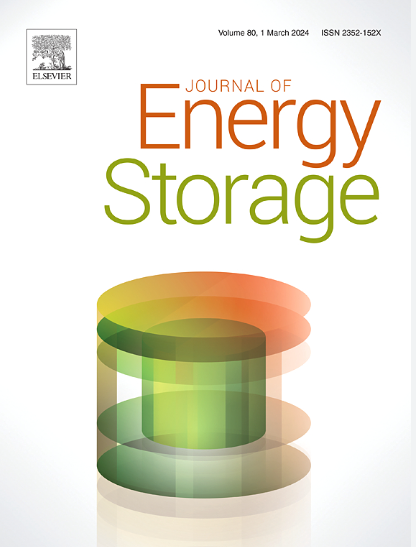Overcharging beha1vior and multi-signal early warning of the LiNi0.6Co0.2Mn0.2O2 lithium-ion pouch cells
IF 8.9
2区 工程技术
Q1 ENERGY & FUELS
引用次数: 0
Abstract
Overcharging of lithium-ion batteries (LIBs) leads to irreversible degradation, failure, and severe thermal runaway (TR). This study systematically investigates the TR behavior of commercial Li (Ni0.6Co0.2Mn0.2) O2//graphite pouch cells under overcharging conditions at different C-rates (0.5, 0.75, and 1C). Based on the evolution of key parameters, the overcharging process could be divided into four stages, and the electrical and thermal behaviors of each stage are studied. Incremental capacity and differential voltage analysis reveals that overcharging disrupts the lithium-ion transport channels, leading to electrode material degradation and side reactions, which in turn increases the risk of TR. This deduction is confirmed through microscopic and spectroscopic characterizations. Post-mortem analysis reveals that overcharging causes the collapse of the layered cathode structure, the formation of large amounts of lithium deposits on the anode surface, and a reduction in the graphitization degree. To enhance the safety of LIBs, a multi-level early warning strategy is proposed according to the changes in multiple signals, such as maximum temperature difference, crest voltage, and the detection of gas. This study through comprehensive analyses, links electrode degradation to TR risk and innovatively proposes a multi-level early warning strategy with clear thresholds based on the evolution of multiple signals during the overcharging process, alleviating the limitations of existing single signal studies. It provides a theoretical foundation for the life management and safety surveillance of lithium-ion batteries under overcharge conditions.
LiNi0.6Co0.2Mn0.2O2袋状锂离子电池过充行为及多信号预警
锂离子电池(LIBs)的过充会导致不可逆转的退化、失效和严重的热失控(TR)。本研究系统地研究了商用Li (Ni0.6Co0.2Mn0.2) O2//石墨袋电池在不同c -倍率(0.5、0.75和1C)下的过充电行为。根据关键参数的演变,将过充过程划分为4个阶段,并对每个阶段的电学和热行为进行了研究。增量容量和差分电压分析表明,过充电破坏了锂离子传输通道,导致电极材料降解和副反应,从而增加了TR的风险。这一推断通过微观和光谱表征得到了证实。事后分析表明,过充电导致层状阴极结构坍塌,阳极表面形成大量锂沉积,石墨化程度降低。为了提高lib的安全性,根据最大温差、峰值电压、气体检测等多个信号的变化,提出了多级预警策略。本研究通过综合分析,将电极退化与TR风险联系起来,创新性地提出了基于过充电过程中多个信号演变的多层次清晰阈值预警策略,缓解了现有单信号研究的局限性。为过充条件下锂离子电池的寿命管理和安全监测提供了理论依据。
本文章由计算机程序翻译,如有差异,请以英文原文为准。
求助全文
约1分钟内获得全文
求助全文
来源期刊

Journal of energy storage
Energy-Renewable Energy, Sustainability and the Environment
CiteScore
11.80
自引率
24.50%
发文量
2262
审稿时长
69 days
期刊介绍:
Journal of energy storage focusses on all aspects of energy storage, in particular systems integration, electric grid integration, modelling and analysis, novel energy storage technologies, sizing and management strategies, business models for operation of storage systems and energy storage developments worldwide.
 求助内容:
求助内容: 应助结果提醒方式:
应助结果提醒方式:


